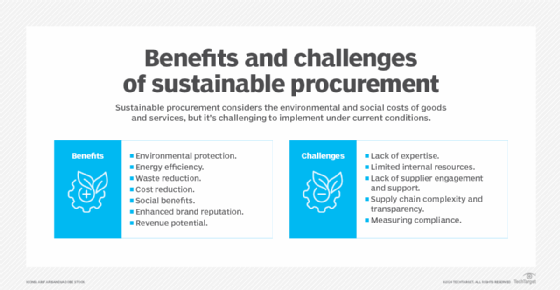What is sustainable procurement?
Sustainable procurement is an approach used by organizations to ensure that environmental, social and economic considerations are part of their purchasing decisions. This approach can also include concepts related to diversity, equity and inclusion (DEI) policies designed to help ensure fairness in the companies and technologies an organization acquires.
In many organizations, sustainable procurement is part of a broader environmental, social and governance (ESG) program that documents a company's impact on the environment and on different stakeholders, and the mechanisms it has in place to hold itself accountable. Some companies make sustainable procurement a part of their corporate social responsibility (CSR) programs.
Procurement is often defined as the cost for a given product or service. With sustainable procurement, the cost is more than just the monetary value of the product or service. Understanding and evaluating the true cost of sustainable procurement includes the overall environmental and social impact of a purchasing decision. The triple bottom line sustainability-focused accounting framework is commonly part of sustainable procurement decision-making.
The concept of sustainable procurement is not just about an individual end product or service offering, but also about analyzing the supply chain to ensure that all aspects of a product or service delivery meet sustainable objectives. The goal is to meet an organization's needs while minimizing negative effects and maximizing benefits for society, the environment and the economy.
Why is sustainable procurement important in organizations?
Here are some of the main reasons sustainable procurement is growing in importance for organizations.
- Environmental impact. A sustainable procurement approach encourages the use of eco-friendly materials and processes. It can help to minimize negative environmental impacts throughout the supply chain by considering factors such as carbon emissions, waste reduction and resource conservation.
- Social responsibility. Sustainable procurement practices can help address social responsibility issues, such as fair labor practices and support of human rights, throughout the supply chain.
- Employee engagement. Sustainable procurement practices can potentially boost employee morale and attract staff who value working for socially responsible companies.
- Regulatory compliance. Certain industries and jurisdictions embrace sustainable procurement practices to comply with evolving environmental and social regulations.
- Risk management. Sustainable procurement can mitigate supply chain risks related to environmental regulations, resource scarcity and reputational damage.
The pillars of sustainable procurement
The three primary pillars of sustainable procurement practices are environmental, social and economic. Here are the main issues that fall under each of the pillars.
1. Environmental
- Carbon footprint and greenhouse gas emissions.
- Energy consumption and efficiency.
- Water usage and conservation.
- Waste generation and recycling rates.
- Use of renewable and recycled materials.
- Biodiversity impact.
2. Social
- Labor practices and human rights.
- Worker health and safety.
- DEI.
- Community engagement and impact.
- Fair wages and benefits.
- Ethical sourcing practices.
3. Economic
- Total cost of ownership.
- Supplier financial stability.
- Innovation and collaboration.
- Local economic impact.
- Risk management
- Long-term value creation
Benefits of sustainable procurement
Benefits from the practice of sustainable procurement span environmental, social and economic dimensions. The following are some of the chief advantages of this approach:
- Environmental protection. By selecting environmentally responsible suppliers and products, organizations can significantly reduce their carbon footprint and pollution levels.
- Energy efficiency. The use of energy-efficient technologies and renewable energy sources leads to lower energy consumption.
- Waste reduction. Recycling, reuse and efficient waste management are key elements of sustainable procurement.
- Cost reduction. Improved efficiency, reduced waste and lower energy bills can lead to cost savings.
- Social benefits. Sustainable procurement champions social benefits such as fair labor practices, safe working conditions and respect for human rights throughout the supply chain.
- Enhances brand reputation. When companies demonstrate a commitment to social responsibility, they often improve brand perception and loyalty among consumers and stakeholders.
- Revenue potential. Companies can tap into new markets and customer segments that prioritize sustainability, potentially increasing revenue.

Sustainable procurement challenges
Key challenges organizations face when implementing sustainable procurement practices include the following:
- Lack of expertise. Many organizations lack understanding of sustainability practices in procurement and there can often be insufficient knowledge on how to evaluate processes.
- Limited internal resources. Implementing sustainable practices requires time, training and funding resources, and organizations sometimes struggle to allocate sufficient resources for it.
- Lack of supplier engagement and support. Suppliers might have different priorities or lack resources to implement sustainable practices.
- Supply chain complexity and transparency. Global supply chains are often complex, making it difficult to trace and monitor every step.
- Measuring compliance. Collecting accurate data and monitoring progress toward sustainability goals is complex.
Best practices for managing sustainable procurement efforts
Building a sustainable procurement approach can take time and effort for organizations of any size. Following are some of the key best practices to manage sustainable procurement efforts to achieve a successful outcome:
- Develop a clear, sustainable procurement policy and strategy. Without a definition and a clear direction, it's hard to meet any goal. Organizations must define sustainable procurement goals and priorities that align with overall organizational ESG objectives and strategy.
- Set clear goals and measure progress. The strategy will set the direction, but it's also essential to establish specific, measurable sustainability targets for procurement. As part of their ongoing efforts, organizations must regularly track and report on key performance indicators for sustainable procurement practices.
- Get executive buy-in. Without the support of leadership and key stakeholders, sustainable procurement efforts will not succeed. Organizations should ensure that sustainable procurement is embedded in the overall company strategy from the top down.
- Integrate sustainability criteria into supplier selection. Include environmental and social factors in all supplier evaluations and RFPs. As part of the integration, develop evaluation scorecards that incorporate sustainability metrics.
- Collaborate with suppliers on sustainability. There can be preexisting relationships and supply chains with suppliers that can also be improved. For those situations, organizations should engage suppliers in sustainability initiatives, providing support to help suppliers improve practices.
- Build internal capacity and awareness. Provide training to staff on sustainable procurement principles and practices to help build internal awareness. From a human resources perspective, it can be very useful to integrate sustainability into job descriptions and performance evaluations so it is literally part of the job.
- Use technology and data. It can be helpful to implement supplier management systems that directly integrate sustainability metrics.
- Continuously improve and innovate. Sustainable procurement is not a point-in-time exercise. Organizations need to regularly review and update sustainable procurement strategies and iterate with new approaches and technologies over time. Part of the continuous improvement process should be to share successes and lessons learned across an organization.
Examples of sustainable procurement initiatives
There are numerous real-world examples of sustainable procurement.
Unilever. The U.K.-based consumer goods conglomerate has a strategy called the Unilever Compass that is designed "to help us deliver superior performance and drive sustainable and responsible growth." The strategy includes sustainable procurement efforts including the Unilever Responsible Sourcing Policy.
Ben & Jerry's. Though the Vermont-based ice cream maker has been a Unilever subsidiary since 2000, it has its own CSR and sustainable procurement efforts. One such effort is the company's responsible dairy sourcing model known as Caring Dairy. The program, which includes supporting fair working conditions for farmers and farm workers, encourages farmers to engage in sustainable farming practices for dairy cows.
Southwest Airlines. The popular airline has a strong focus on CSR and ESG, detailed in the company's annual "One Report" document. One specific sustainable procurement effort underway at the airline is an initiative to secure sustainable aviation fuel aimed at helping the company meet its goals of net-zero carbon emissions by 2050.
Walmart. As one of the world's largest retailers, Walmart has a massive supply chain. It's sustainable procurement effort, called Project Gigaton, seeks to reduce or avoid one gigaton of greenhouse gas (GHG) emissions from its global supply chain by 2030. Suppliers participating in the initiative are required to set science-based targets and report their emissions reductions annually.
Government of Canada. The Government of Canada requires major suppliers to disclose their GHG emissions and set reduction targets. This is part of a broader effort to meet Canada's net-zero commitments and includes standards to reduce the carbon footprint in construction projects.







